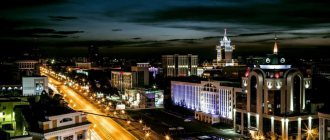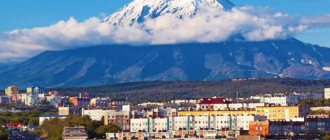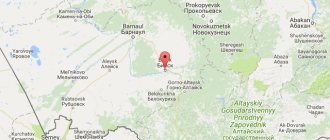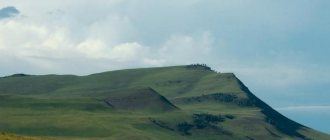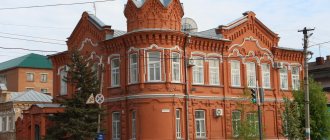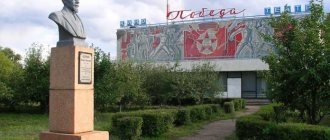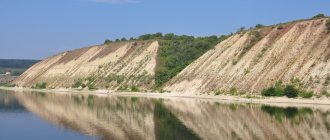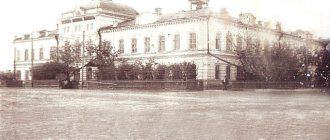Geographical location, rivers, lakes, relief
The map of Russia shows that the Saratov region is located in the southeastern part of the European territory of the Russian Federation. The subject borders the Orenburg, Samara, Voronezh, Tambov, Volgograd, Ulyanovsk and Penza regions. The eastern border of the region is the state border of the Russian Federation and Kazakhstan.
Districts of the Saratov region
The subject consists of 38 districts. The satellite map of the Saratov region shows that the Volga divides the region into Left Bank and Right Bank parts. In the north of the subject there is the Khvalynsky district, in the south - Aleksandrovo-Gaisky, in the west - Romanovsky, in the east - Perelyubsky.
The largest by area is the Dergachevsky district (4500 km2), the smallest are Baltaysky and Romanovsky with the same area of 1300 km2.
Natural and climatic conditions
The climate of the region is continental with frosty winters and dry summers. The average temperature in the winter months is -10 to -14ºC, but can drop to -35ºC. Summer in the region lasts four months. Average summer temperatures are +21 - +24ºC, in the hottest weather the air warms up above 30ºC.
Most of the territory is occupied by chernozem steppes; in the southeast there are semi-deserts.
In addition to the Volga, water resources are represented by 180 small rivers.
The Saratov region is a land of diversity
The Saratov region is a wonderful region located in the southeast of the European part of Russia, in the northern part of the Lower Volga region, and is part of the Volga Federal District of the Russian Federation. The Saratov region borders on the Volgograd region in the south, on the Tambov region on the southwest, on the Voronezh region on the west, on the Penza, Samara, Orenburg and Ulyanovsk regions on the north, and on the east on the Republic of Kazakhstan. The administrative center is the city of Saratov. From west to east the territory extends for approximately 570 km, and from north to south for approximately 330 km. It is interesting that the full-flowing Volga River, flowing, divides the Saratov region almost in half into two parts: left and right.
Saratov, Volga embankment
This region pleases the eye with its open spaces and picturesque landscapes; it has unique beauties that are not repeated anywhere else. Here are the Volga Upland, the Trans-Volga steppe plains, and the deserted Caspian Lowland.
The climate of the Saratov region is temperate continental. It is characterized by aridity and great weather variability - droughts occur on average once every three years. The continental climate increases from north to southeast - the amplitude of air temperature fluctuations increases and the amount of precipitation decreases. In the Left Bank region the climate is more arid, the weather is hot in summer with little precipitation, and winter has little snow with low relative humidity. The climate of the Right Bank of the Saratov region is milder, with more rainfall, than in the Left Bank.
Summer in the Saratov region lasts about four months, the weather is usually partly cloudy and dry. Precipitation falls unevenly, in the form of showers with thunderstorms. Often the entire monthly precipitation amount can consist of one or two rains. The hottest month is July, with an average daily air temperature of +25 degrees, but often from the beginning of July to mid-August there is hot weather with temperatures not lower than +30 degrees. At the same time, strong dry winds are observed in the Left Bank region, causing droughts.
Winter in the Saratov region begins at the end of November and lasts about four months. The weather in winter is quite frosty: from -10 degrees in the Right Bank to -14 degrees in the Left Bank, but frosts down to -30 degrees, as well as thaws, often occur. The coldest month of winter is January, with an average daily temperature of about -12 degrees. In February the weather is windy, with frequent snowstorms.
The diversity of the flora of the Saratov region is influenced by landscape zones: steppe, forest-steppe and semi-desert. Starting from the northern part of the Saratov region, there are oak forests, steppes, mixed forest cover and even deserts. All this splendor of natural diversity continues for 200 km to the south of the region. Large but uneven areas, mainly on the Right Bank, are occupied by forests, where there are 1,600 species of bush and tree species. In the oak forests you can find wild pear and apple trees, rowan, birch, linden, sycamore maple, ash and elm.
The fertile chernozem soil of the steppe zone, the uniformity of heat and light make it possible to grow the best durum wheat in the country, for which the Saratov region is often called the birthplace of strong cereals.
The nature of the Saratov region is truly picturesque
Due to active cultivation of the land, many plant species have been lost, but still in untouched virgin zones, on slopes and in ravines, carnations, yellow chamomile, various types of feather grass, alfalfa, wormwood, and astragalus are found. But the most common are sweet clover, yarrow, speedwell and tansy.
Along the main rivers - the Volga, Khopra, Izgir and Tereshka - floodplain forests have formed, where there are both poplar and willow. But the main feature is that relict forests are widespread in the region, and this has a positive effect on the preservation of flora. For this purpose, nature reserves and national parks were created: “Moss Swamp”, “Floodplain Oak Forest”, “Tulip Steppe”, etc.
The fauna of the Saratov region, just like the flora, depends on natural areas and human activity. For example, in the steppe zone of the Lower Volga region, before active cultivation of the land, the permanent residents were the saiga antelope, the tarpan horse, the roe deer and the red deer. But, alas, today, except for the saiga, it is unrealistic to meet these mammals. Small rodents are often found: ground squirrels, voles, hamsters, pieds, jerboas, steppe choruses. Feathered representatives - cranes, larks, bustards. Forest-steppe forests and oak groves are inhabited by deer, elk, foxes, wolves, hedgehogs, squirrels, and hares. Gophers and gerbils live in the semi-desert zone. Interesting fact: the Volga River, as a border, does not allow rodents to spread; they live only in the Volga region.
The mixed flora and fauna of the European and Asian parts of the continent gives the region a unique charm. Moreover, 400 out of 1,700 plant species growing on the fertile soils of the Saratov region are listed in the Red Book. The region boasts 70 species of mammals and more than 250 subspecies of birds.
The Saratov region has several natural monuments protected at the state level. Here are just a few of them.
Pine forest in a steppe oasis . An extraordinary natural phenomenon is a pine forest among the steppe plain. An amazing feature of this reserve is the very fact of its existence: in the steppe zone, nature suddenly created an incredible contrast with the environment - as if it had transferred the Siberian forest to the center of the sands. For all its incredibleness, the pine forest of the Volsky region has pine trees that are over 100 years old and at least 15 meters in height.
Despite the presence of obvious signs of the natural origin of the pine forest, there is a legend among residents about its artificial appearance. Allegedly, a certain nobleman Kokuev ordered the territory to be planted with pine trees in the second decade of the 19th century.
The Ivanovo Field tract is a tulip field with an area of 150 hectares. On the territory of this natural monument, one of the largest populations of the Gesner tulip is noted - a species listed in the Red Book of the Saratov Region with the category and status of “endangered”.
Tract "Ivanovo Field"
The Karaman Delta and the Volga itself create a bizarre network of an infinite number of channels, islands, and bays, which stretches down the Volga along the left bank for tens of kilometers. Herons, ducks, swans, wild boars, beavers - these birds and animals inhabit the Black Waters reserve , which can well be called the Saratov “Amazon”. This large massif of the Volga floodplain on the left bank, located in two districts - Marksovsky and Engelssky, is considered one of the best places for fishing in the region.
At the junction of the Middle and Lower Volga regions, in the north of the Saratov region, the largest national park in the Lower Volga region is located - Khvalynsky . The uniqueness of its nature is due to the fact that the Khvalynsky Mountains, within which the park is located, are the highest in the Volga Upland. The park was formed in 1994 to preserve the unique natural complexes of the Khvalynsky chalk mountains of the Volga Upland and monuments of the historical and cultural heritage of this region. In addition to the natural and recreational resources of the park, one cannot help but say about the historical and cultural uniqueness of the protected zone, first of all, about the historical city of Khvalynsk. This is a city with preserved historical architecture, sanatoriums on the site of Old Believer hermitages, local history and art museums, as well as ponds and springs, apple orchards.
The valley of the Khoper River in the Saratov region has finally become a natural monument. The area of the new specially protected natural area is 1,600 hectares. The goal is to preserve a unique complex of untouched nature of old floodplain oak forests. Tourists are attracted here by the most beautiful places in the Khopra Valley, picturesque shores, pristine sandy beaches, warm, crystal clear water, excellent fishing, pine forests on high terraces, and piercingly clean air. The Khopra Valley is covered with rich broad-leaved forests with linden and elm; in the middle reaches there are also pine groves. Khopr's path to the Don is long and winding. There are often islands in the channel, and between them, in the channels, there are rapids, behind which whirlpools can arise.
Khoper River
Marfinsky Park was created at the estate of Count Silvan Vladislavovich Korevitsky in the village of Marfino in 1905–1910. Having married the daughter of the landowner Belyaev, Maria Dmitrievna, the young count decided to build a beautiful park in honor of this event. To do this, he hired gardeners from France who selected trees and shrubs for the future park. The main alley, according to legend, was planted in the form of the Korevitsky family monogram - a curved letter “K”. Canals were dug from the Kolyshley River to irrigate the park. Alleys, clearings, and a pond with strange fish appeared. In the center of the pond, on an island, there was a gazebo, where a brass band made up of peasants played, and artists performed, entertaining the guests. Japanese-style openwork bridges led to the island. And in the clearing in front of the gazebo there were flower beds planted with flower seeds brought from Japan and China. Marfinsky Park is the most significant parkland in the region (there are more than 400 trees) and one of two places where relict fir is represented in large numbers.
Marfinsky Park
The Nizhne-Bannovsky natural monument occupies a vast part of the southern outskirts of the Saratov Volga region. The natural complex as a whole and its individual components are unique. Due to the inaccessibility for economic activity in certain parts of the reserve, little changed natural complexes have been preserved, reflecting the typical and unique features of these places. For example, in the Juniper ravine the only population of Cossack juniper in the Saratov region grows. On the upper remnant massifs of the Volga Upland, on the steep, steep slopes of the Volga coast, in deep ancient gullies, typical and currently extremely rare areas of virgin and old-fallow steppes have been preserved.
In 2012, the remains of a dinosaur were found here, and not just any herbivorous diplodocus, but a mosasaurus. This once again confirms the theory that in the place where the Saratov region is now located, there was once a large ancient sea, since mosasaurs are dinosaurs that lived in the seas and oceans. Immediately behind the Juniper ravine, Mount Syrt rises 217 meters. This mountain is famous for the fact that on its slopes rocks from almost all centuries of the Upper Cretaceous period are exposed, or, as geologists say, the entire Upper Cretaceous section.
The unusually beautiful bank of the Volga from the village of Melovoe through the village of Nizhnyaya Bannovka and to the village of Belogorskoye is also called the “Bank of Plesiosaurs”. One of the most famous finds here was made in the summer of 1981 - a large, almost two-meter skull of an ichthyosaur.
Natural monument "Nizhne-Bannovsky"
The natural resources of the region delight visitors with their beauty. The Volga River itself, with its sandy beaches, hundreds of islands and channels, opportunities for fishing and hunting, constitutes the enormous wealth of our land. In the Saratov region there is a place where the great river is wide, like a boundless sea.
REFERENCE
On March 2, 1945, by a special resolution of the Council of People's Commissars of the USSR, the Saratovgaz . He became a reliable executor and coordinator of all work related to the widespread gasification of the regional center. In the shortest possible time, a reliable system of underground gas pipelines, street and house networks was built.
In the 1940s, the priority tasks were to lay gas pipelines and supply gas to industrial enterprises. Over four years, the length of the networks increased more than fivefold and amounted to 112.87 km; 77 factories in the city of Saratov operated on gas.
In 1949, by order No. 234, the Ministry of Economic Affairs of the RSFSR approved the project for the first stage of gas supply to Saratov. In the same year, the general gas supply project for the city was approved. By 1951, the length of gas networks increased to 245 km, and the supply of gas for domestic needs tripled compared to 1945. In 1951, the Saratovgaz trust was renamed Saratovgorgaz. In 1994, the Saratovgorgaz trust was transformed into OJSC Saratovgaz, now JSC Saratovgaz.
The company is part of a group managed by Gazprom Mezhregiongaz LLC. The main activity is uninterrupted, safe, accident-free transportation of gas to consumers.
JSC Saratovgaz is a gas distribution network with a total length of 2898.5 km, 1054 gas control points and cabinet installations, 332 electrochemical protection installations. The production capacity of the gas distribution organization makes it possible to supply 394,149 apartments, 144 industrial and 2,828 municipal enterprises with natural gas. The company operates 437.68 km of underground steel gas pipelines with a service life of 40 years or more. The amount of gas transported through gas distribution networks is 1845.453 million m3 per year. All hydraulic fracturing units are equipped with automated control systems for gas distribution technological parameters. The company employs more than 850 people.
Transport connections of the Saratov region, roads and routes on the map
The region has developed transport links; people can get here by plane, train, or road transport.
State highways pass through the Saratov region:
- Syzran - Saratov - Volgograd (P228);
- Saratov - Voronezh - Kursk (A144);
- Saratov - Penza - Saransk - N. Novgorod (P158);
- Samara - Volgograd (P226).
Rail transportation to Russian cities:
- Astrakhan
- Saint Petersburg
- Novokuznetsk;
- Perm and others.
There are long-distance train routes to Belarus, Bulgaria, and Germany.
The Volgograd-Kazan railway passes through the regional center.
The map of the Saratov region with its districts shows communication routes within the region by buses, electric trains and minibuses.
Content
- 1 Cities of the Saratov region
- 2 Economy of the region 2.1 Major projects
- 2.2 News about the development of the region
- 2.3 Enterprises of the region 2.3.1 Enterprises of the mechanical engineering industry
- 2.3.2 Enterprises of the fuel and energy complex
- 2.3.3 Enterprises of the chemical complex
- 2.3.4 Metal and plastic processing plants
- 2.3.5 Light and textile industry enterprises
- 2.3.6 Woodworking and furniture production enterprises
- 2.3.7 Construction industry enterprises
- 2.3.8 Enterprises of the agro-industrial complex
- 2.3.9 Food industry enterprises
- 2.3.10 Folk arts and crafts enterprises
- 2.3.11 Other enterprises
- 6.1 Photo reviews of the region
Links
- Government portal of the Saratov region
- "Multifunctional center for the provision of state and municipal services (MFC) of the Saratov region"
- Saratov region
- Made in Saratov region
Photo reviews of the region
- Strategic bombers at the air base in Engels. Chistoprudov 2011
- Balakovo NPP is the most powerful nuclear power plant in Russia Gelio 2015
| [ + ] Regions of Russia | |
| Regions of the North-West (NWFD) | St. Petersburg • Leningrad region • Arkhangelsk region • Vologda region • Kaliningrad region • Karelia • Komi • Murmansk region • Nenets Autonomous Okrug • Pskov region |
| Regions of the Volga region (VFD) | Bashkortostan • Volgograd region • Kalmykia • Kirov region • Mari El • Mordovia • Nizhny Novgorod region • Orenburg region • Penza region • Perm region • Samara region • Saratov region • Tatarstan • Udmurtia • Ulyanovsk region • Chuvashia |
| Regions of Southern Russia (SFD) | Sevastopol • Republic of Crimea • Adygea • Astrakhan region • Krasnodar region • Rostov region |
| Regions of the North Caucasus (NCFD) | Dagestan • Ingushetia • Kabardino-Balkaria • Karachay-Cherkessia • North Ossetia • Stavropol Territory • Chechen Republic |
| Regions of the Urals (Ural Federal District) | Kurgan region • Sverdlovsk region • Tyumen region • Khanty-Mansi Autonomous Okrug - Yugra • Chelyabinsk region • Yamalo-Nenets Autonomous Okrug |
| Regions of Siberia (Siberian Federal District) | Altai Republic • Altai Territory • Irkutsk Region • Kemerovo Region • Krasnoyarsk Region • Novgorod Region • Novosibirsk Region • Omsk Region • Tomsk Region • Tyva • Khakassia |
| Regions of the Far East (FEFD) | Amur Region • Buryatia • Jewish Autonomous Region • Trans-Baikal Territory • Kamchatka Territory • Magadan Region • Primorsky Territory • Yakutia • Sakhalin Region • Khabarovsk Territory • Chukotka Autonomous Okrug |
| see also | Regions of Russia • Federal districts of Russia • Abolished subjects • Economic regions of Russia • Cities of Russia |
Economy of the region
Large projects
- Electrification of the section Saratov - Petrov Val - M. Gorky - Kotelnikovo (2000-2005)
- Production of Lada Kalina at AvtoVAZ (2007)
- Electrification of the Syzran - Sennaya section with the construction of the second main track (2008)
- New Saratov Bridge (2009)
- Severstal - Balakovo Long Products Plant (2014)
Projects under construction
- Construction of a new airport “Central” in Saburovka (Saratov district)
- Comprehensive modernization of the Saratov HPP
- Residential area named after Yu. A. Gagarin (“Solnechny-2”), Saratov
News about the development of the region
- December 17, 2015. A high-tech module for the efficient process of processing blood and its components was launched in Saratov.[1]
- February 17, 2021. A large gas condensate field with confirmed gas reserves of 420 million cubic meters was discovered in the Ershovsky district. m.[2]
- March 2, 2021. In the Saratov region, the first Russian plant for the production of thermal insulating PIR boards reached production capacity.[3]
- June 15, 2021. More than 70 investment projects are currently being implemented in the Saratov region, the total investment of which is over 260 billion rubles.[4]
- October 25, 2021. The Russian enterprise Metal Structures Plant, which is located in the city of Engels, as part of the import substitution program, began production of tank cars for transporting chlorine, which were previously purchased in Ukraine.[5]
- February 3, 2021. A new deposit of the strategically important metal rhenium was discovered in the Saratov region. Until this point, rhenium was mined in Russia only on the Kuril Islands.[6]
- March 13, 2021. It became known that at the investment forum in Sochi an agreement was signed between the Government of the Saratov Region and JSC NPK Khimpromengineering on the construction of a large synthetic fiber production facility in the region. It is planned that about 5.2 billion rubles will be spent on the project.[7]
Saratov
- March 14, 2021. The second plant for the production of TOREX brand steel doors was opened in Saratov. The total investment volume exceeded 500 million rubles.[8]
- March 19, 2021. At the investment forum “Sochi-2017”, an agreement was signed between the Federal Air Transport Agency, the Government of the Saratov Region and PJSC SarAero-Invest on the construction of a new airport “Central” in the region. The cost of the project is estimated at 20 billion rubles.[9]
Balakovo
- December 9, 2015. A new road bridge across the Volga shipping canal was inaugurated in Balakovo.
Construction began in 2009, the four-lane bridge has a length of 1070.3 meters, the total length of the bridge crossing is 2.58 kilometers. [10]
Enterprises of the region
Enterprises of the mechanical engineering industry
Expand
Enterprises of the fuel and energy complex
Expand
Chemical complex enterprises
Expand
Metal and plastic processing plants
Expand
Light and textile industry enterprises
Expand
- Baltex LLC https://newbaltex.ru/ - produces synthetic and mixed fabrics: lining, jacket, windproof, raincoat and backpack.
Woodworking and furniture production enterprises
Expand
Construction industry enterprises
Expand
Enterprises of the agro-industrial complex
Expand
Food industry enterprises
Expand
- “Gifts of the Fields”, LLC - https://darypoley.ru/ - cereals, flour, sugar, groceries. Brand "Ecoline".
- "Commodity Economy", LLC https://www.tho.ru/ - little sunflower. Brands “Dary Povolzhye”, “Domashnee”, “Leya”, “Mirra”, “Saratovskoe”.
- https://trilitra.ru/ - produces juices, nectars, juice drinks, lemonades under the brands “Shirokiy Karamysh”, Zu100, “Village Juices”, “Sandra”.
Folk arts enterprises
Expand
- “Eva-Gold” https://eva-gold.ru/ - jewelry.
- LLC "Uvikom" https://www.uvikom-sar.ru/ - jewelry.
Other enterprises
Expand
- https://www.neostatus.ru/ - advertising and printing products.
